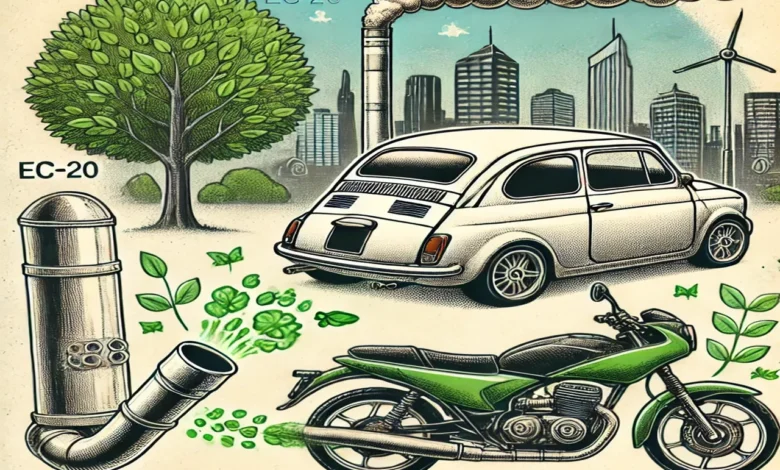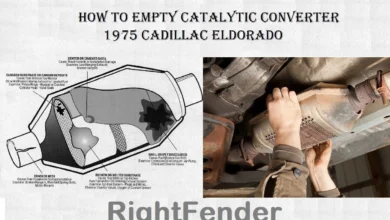
Vehicle emissions have become one of the primary contributors to global air pollution, with harmful pollutants such as carbon dioxide (CO2), nitrogen oxides (NOx), and particulate matter being released into the atmosphere daily. These emissions not only degrade air quality but also contribute to global warming and cause severe health issues, particularly in urban areas.
Despite various environmental regulations in place, vehicle emissions continue to grow due to outdated vehicles on the road, insufficient maintenance, and a lack of awareness about the latest emission control technologies. Poor testing and monitoring further exacerbate the situation, allowing harmful emissions to go unchecked.
As countries worldwide tighten emissions regulations, vehicle owners are under growing pressure to adopt technologies like EC-20 emission control systems for cars and the kd125kgk2 exhaust emission system for motorcycles. By integrating these modern systems and committing to regular emissions testing, drivers can play a pivotal role in reducing their carbon footprint and protecting the environment.
Understanding the Sources and Impacts of Exhaust Emissions
What is Emissions Verification?
Emissions verification is the process of evaluating and certifying that a vehicle meets the required emission standards set by regulatory bodies. This process is critical in ensuring that the vehicle’s exhaust emissions remain within permissible limits, contributing to cleaner air. Verification typically involves testing the levels of pollutants like carbon monoxide (CO), hydrocarbons (HC), and nitrogen oxides (NOx) emitted by vehicles.
Why Emissions Verification Matters?
Emissions verification is crucial for several reasons:
- Environmental Protection: Vehicles emit harmful pollutants such as carbon dioxide (CO₂), nitrogen oxides (NOx), and particulate matter. Verifying emissions helps ensure these pollutants are within regulatory limits, reducing air pollution and mitigating climate change.
- Public Health: High levels of vehicle emissions contribute to respiratory issues, heart diseases, and other health problems. Emissions verification ensures that vehicles meet standards that minimize health risks, improving air quality.
- Compliance with Regulations: Many countries and regions have strict emissions regulations to limit the environmental impact of vehicles. Regular verification ensures vehicles comply with these laws, avoiding legal penalties.
- Sustainability: Verifying emissions supports the transition toward cleaner and more sustainable transportation, promoting the use of eco-friendly vehicles such as electric or hybrid models.
- Performance Efficiency: Vehicles that emit excessive pollutants may be inefficient or poorly maintained. Emissions checks often help identify mechanical issues, leading to better fuel efficiency and longer vehicle lifespan.
What Causes Emissions?
Vehicle emissions are caused primarily by the combustion of fossil fuels, such as gasoline and diesel, in internal combustion engines. Incomplete combustion results in the release of pollutants, including CO2, NOx, CO, and particulate matter.
Many factors such as engine wear, poor maintenance, and the use of low-quality fuel can further contribute to increased emissions. In motorcycles, outdated exhaust systems play a significant role in emitting harmful gases.
How Do You Detect Emissions?
Emissions can be detected through vehicle inspection programs, which utilize gas analyzers to measure pollutant levels from the exhaust. Testing is conducted at certified emissions testing stations, where the vehicle is run through various speeds and loads to simulate real-world driving conditions. This allows for accurate detection of harmful emissions that could be detrimental to the environment.
How Are Emissions Calculated?
Emissions are calculated using specialized equipment that measures the concentration of pollutants in the exhaust gases. These measurements are taken under specific operating conditions, and the data is then compared against established environmental standards. Advanced technologies, such as onboard diagnostics (OBD) systems in modern vehicles, can also provide real-time emissions data to ensure compliance.
What Are Emissions Fees?
Emissions fees are charges imposed on vehicles that fail to meet the emission standards set by environmental authorities. These fees are designed to encourage vehicle owners to maintain their vehicles properly and adopt cleaner technologies. In many regions, vehicles with high emissions are subject to higher fees, incentivizing the use of environmentally friendly vehicles.
Comparative Analysis of 5 Emissions Testing Stations
Choosing the right emissions testing station not only ensures your vehicle complies with local regulations but also can impact your overall service experience, costs, and even vehicle performance. Below is a comparative analysis of five prominent emissions testing stations, outlining their strengths, weaknesses, and overall effectiveness.
1. ADEQ Vehicle Emissions Testing Station
The Arizona Department of Environmental Quality (ADEQ) operates numerous emissions testing stations across the state. Their service is widely known for its efficiency and quick processing. With several locations, ADEQ ensures that residents can access a testing center without traveling long distances. The staff is well-trained, ensuring that emissions testing is carried out to meet all state and federal regulations. The wait times are generally short due to the efficient workflow and ample staffing.
One of the downsides of ADEQ is the limited flexibility in terms of scheduling appointments. Many stations operate on a first-come, first-served basis, which can result in extended wait times during peak hours.
2. Air Team Vehicle Emissions Testing Station
Air Team stations are known for their state-of-the-art testing equipment, ensuring accurate results and compliance with emissions standards. These stations are highly regarded for their customer service and thorough testing procedures. They offer a user-friendly online platform for scheduling appointments, reducing wait times and making the process more convenient. Their facilities are clean, and the staff is highly attentive, making sure all customers’ concerns are addressed.
The primary drawback of Air Team Vehicle Emissions Testing Stations is the higher cost of service compared to some of their competitors. While their service quality is excellent, the premium pricing may deter budget-conscious individuals, especially those with older vehicles that may require frequent testing or repairs.
3. DEKRA Emission Check
DEKRA is a globally recognized emissions testing provider, operating in multiple countries with a strong reputation for thoroughness and consistency. Their global presence ensures that the same high standards are applied regardless of location. DEKRA uses advanced emissions testing technologies and ensures that their stations are equipped to handle a wide range of vehicle types, from passenger cars to commercial trucks.
Due to its global operations, DEKRA tends to have a more corporate feel, with less emphasis on customer interaction compared to locally owned stations. The process can be more standardized and less personalized, which might make some customers feel like just another number.
4. Emission Inspection Strasburg VA
As a smaller, local emissions testing facility, Emission Inspection Strasburg VA offers personalized service and attention to detail. Their customers often report that the staff takes time to explain the results of the test, offering insights into how vehicle owners can reduce their emissions and improve their vehicle’s performance. The local ownership creates a community-focused environment, which can be appealing for customers looking for a more personal touch.
Being a smaller station, Emission Inspection Strasburg VA may not have the same level of advanced testing equipment as larger providers like DEKRA or Air Team. This could potentially lead to less precision in test results.
5. Jiffy Lube Emissions
Jiffy Lube is a well-known brand in the automotive service industry, offering a wide range of vehicle maintenance services, including emissions testing. Their convenience is a major plus, as Jiffy Lube stations are located across the country, providing easy access to emissions testing services no matter where you are. Additionally, Jiffy Lube Emissions offers rebate coupons, that are a good choice for average class people to avoid Govt penalty on emission.
The popularity and coupons of Jiffy Lube can lead to long wait times, especially during peak hours. While they offer a variety of services, the quality of their emissions testing may not be as specialized as stations that focus solely on emissions control.
Comparison Table:
| Station | Pros | Cons |
| ADEQ Vehicle Emissions | Efficient service, multiple locations, state-certified | Limited scheduling flexibility, impersonal service |
| Air Team Vehicle Emissions | Thorough testing, user-friendly scheduling, great customer service | Higher cost, fewer locations |
| DEKRA Emission Check | Global presence, standardized testing, eco-friendly | Less personalized service, potentially slower turnaround |
| Emission Inspection Strasburg | Personalized service, local ownership, detailed testing | Limited advanced equipment, longer wait times |
| Jiffy Lube Emissions | Convenient locations, additional services like oil changes | Long wait times, emissions testing can feel rushed |
Each station offers distinct advantages and drawbacks depending on what you prioritize—whether it’s convenience, customer service, cost, or the level of detail in testing.
You might also like: How to Unclog a Catalytic Converter and Save Your Exhaust System
Solutions for Emission Reduction
Reducing exhaust emissions from vehicles is not only essential for improving air quality but also a responsibility that individuals and businesses must undertake to combat climate change. Here are several practical solutions that vehicle owners can adopt to contribute to a cleaner environment:
1. Use of Modern Emission Control Technologies
One of the most effective ways to reduce emissions is by adopting advanced emission control technologies. For cars, catalytic converters and diesel particulate filters (DPF) are crucial. These devices help convert harmful gases such as carbon monoxide and nitrogen oxides into less toxic emissions.
2. Regular Emissions Testing and Maintenance
Frequent emissions testing and regular vehicle maintenance are essential in keeping exhaust emissions low. Many vehicles release higher levels of pollutants due to poor maintenance practices, such as clogged filters, worn-out catalytic converters, or damaged exhaust systems.
3. Adopting Cleaner Fuels
The type of fuel used in vehicles has a significant impact on the amount of emissions produced. Cleaner alternatives, such as biofuels, compressed natural gas (CNG), and electric power, can drastically reduce the pollutants released into the atmosphere.
Switching to biofuels can reduce carbon dioxide emissions, as these fuels are made from renewable organic sources that produce fewer harmful gases when burned.
Electric vehicles (EVs), on the other hand, produce no tailpipe emissions, offering a zero-emission alternative. Although EVs still rely on electricity generated from various sources (some of which may be non-renewable), the overall emissions are considerably lower than those from gasoline or diesel-powered vehicles.
4. Vehicle Upgrades
Another important solution to reduce vehicle emissions is to upgrade older vehicles with modern emission control technologies. Vehicles manufactured more than a decade ago may not be equipped with the latest catalytic converters, DPF systems, or other emissions-reducing technologies. By retrofitting vehicles with modern solutions such as the EC-20 system for cars or the kd125kgk2 system for motorcycles, vehicle owners can ensure that even older models comply with current emission standards.
Many local governments offer subsidies or incentives for upgrading to cleaner technologies such as the EC-20 system, making it easier for vehicle owners to afford these upgrades.
EC-20 Emission Control: Revolutionizing Car Emissions
The EC-20 emission control system is a cutting-edge technology designed to reduce harmful emissions from vehicles. By optimizing the combustion process and improving the efficiency of catalytic converters, EC-20 helps reduce the levels of CO2, NOx, and other pollutants in vehicle exhaust. This system is becoming increasingly popular due to its ability to significantly lower emissions, making it a key solution in the fight against air pollution.
Advantages of EC-20
- Reduces harmful emissions by improving the vehicle’s exhaust system.
- Helps vehicles meet stringent emissions standards.
- Enhances fuel efficiency, contributing to lower fuel costs.
- Can be retrofitted in many existing vehicles, making it accessible for older cars.
Why EC-20 Matters: With increasing regulatory pressure to reduce emissions, EC-20 is becoming a standard for eco-friendly vehicles. It helps vehicle owners comply with emission standards while contributing to a cleaner environment. By adopting technologies like EC-20, individuals can make a significant impact on reducing overall pollution levels.
Reducing Emissions in Bikes with kd125kgk2 Exhaust Emission System
For motorcycle enthusiasts, reducing exhaust emissions is just as important as it is for car drivers. The kd125kgk2 exhaust emission system is a popular choice among bikers looking to lower their carbon footprint. This system optimizes the exhaust flow and reduces harmful emissions by improving the combustion process, resulting in cleaner exhaust gases.
Why Bikers Should Adopt the kd125kgk2 Exhaust Emission System:
- Eco-Friendly: Significantly reduces the levels of NOx and CO in motorcycle emissions.
- Improved Performance: Enhances engine performance by optimizing the exhaust system.
- Cost-Effective: Provides long-term savings by improving fuel efficiency.
- Compliance: Helps motorcycles meet stringent environmental regulations.
Adopting the kd125kgk2 exhaust emission system allows bikers to contribute to a cleaner environment while maintaining optimal performance. This system is an excellent choice for those committed to reducing their environmental impact.
At the End
Reducing vehicle emissions is a shared responsibility, and by adopting modern technologies such as the EC-20 emission control system for cars and the kd125kgk2 exhaust emission system for motorcycles, individuals can play a crucial role in improving air quality. Regular emissions testing, maintenance, and the use of cleaner fuels are essential steps toward a sustainable, eco-friendly future. By making informed decisions, we can all contribute to reducing harmful emissions and protecting the environment for generations to come.
We hope you found this article helpful. If you did, be sure to check out our blog for more great content like this.





